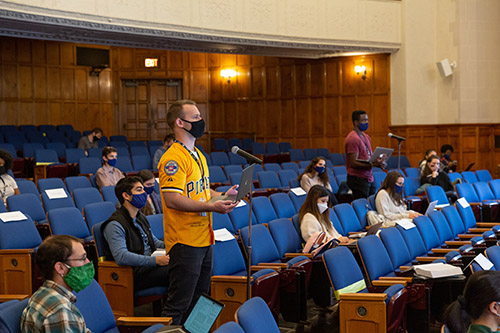Transforming Legal Education While Navigating the Pandemic

The hallways of the Sterling Law Building and Baker Hall look quite different these days.
Desks are spread far apart, plexiglass covers the lecterns, and large television monitors hang at the front of the classrooms. Traditional spaces like the Ruttenberg Dining Hall and student lounges have been remade into makeshift classrooms. Tents and outdoor heaters have been set up in the courtyards. Signage reminding the community to follow public health protocols is ever-present. And yet, despite the drastic physical transformation to accommodate hybrid learning in the midst of a once-in-a-century pandemic, the thought-provoking classroom discussions and the critical work of Law School clinics, centers, and programs carry on with the same vigor that they always have.
VIEW A PHOTO GALLERY OF HYBRID LEARNING 4
Students in the Levinson Auditorium during a hybrid class this fall.
Through hard work and a deep spirit of ingenuity, the Law School community came together to rise to an enormous challenge. Over the course of this year, faculty, students, and staff — both here in New Haven and all around the world — made the best of a difficult and ever-changing situation.
“I’m heartened that this fall we’ve had about 40 percent of our courses with substantial in-person teaching,” said Deputy Dean and Professor Ian Ayres ’86, who worked to get the faculty ready for this major change. “Professors even made use of the sideless tents in the courtyards for review sessions and one-on-one office hours. I’ve been impressed with how nimbly we’ve transformed the Law School inside and out.”
After adapting rapidly to online learning in the spring, the summer months gave faculty and administrators much needed time to prepare for a hybrid model. The transformation took place at every level. Facilities worked with an architectural firm to rethink classrooms, convert spaces, improve ventilation systems, and equip every area with the personal protective equipment needed to teach and learn safely. The IT department provided training to faculty and ensured every classroom had the right audio/visual systems to create a sense of connectedness. And administrative departments worked around the clock to make sure students and faculty had the support they needed to make it all work.
“It feels like normal teaching to me in some sense. I’ve gotten used to going to class in my mask and logging into Zoom.” — Professor Oona Hathaway ’97
“This was a herculean effort by our faculty and staff, who worked tirelessly to make hybrid learning a success. It was an enormous lift,” said Dean Heather K. Gerken. “I am also very grateful to our students, who have been compassionate and patient as we all worked together to navigate this changing landscape. I’ve never been more proud of this community.”
One major key to success to hybrid learning was the technology itself, which faculty quickly learned to use to their advantage. Zoom provided the ability to bring in renowned guests from all over the world, use new digital tools like real-time polling, and connect students no matter how they joined class.
“It feels like normal teaching to me in some sense,” said Professor Oona Hathaway ’97, who led a faculty workshop on hybrid teaching. “I’ve gotten used to going to class in my mask and logging into Zoom.”
Hathaway used Zoom in her 10-person Foreign Relations and International Law class to promote lively discussion in the hybrid environment.
“I had all my students log on to Zoom, no matter if they were in-person or remote, to be able to see who was talking at all times,” said Hathaway. “It worked extremely well. Everyone could hear and see each other and was a part of the conversation.”
Preston Lim ’21, who experienced Hathaway’s class both in-person and remotely, said the technique made the class feel seamless no matter how you engaged.
“Professor Hathaway made sure to call on Zoom students frequently and created a classroom experience that was both smooth and equitable,” said Lim. “Despite the fact that all attendees wore masks, the class felt no different from a pre-COVID seminar. Students were able to engage in back-and-forth conversation and Professor Hathaway was able to ask on-the-spot, follow-up questions.”

A tent in the Law School Courtyard created extra space for socially distanced classes and other meetings.
For larger classrooms, like Professor Nick Parillo’s Administrative Law class, technology was also central to creating an inclusive feel and promoting active participation among the 40 students in his class.
“We had one or two class discussion segments in each two-hour class,” explained Parrillo, who taught his class in a transformed Ruttenberg Dining Hall. “I pose one or two broad-gauged questions, and the students have ‘mini discussions’ of those questions with each other for about five minutes.” Online students used Zoom breakout rooms to handle the discussions, while those in person joined together from a safe distance. Parrillo would then cold call students no matter where they were taking the class, encouraging them to share their thoughts.
Utilizing the hybrid format both in larger classes and small seminars enabled students to obtain as close to a normal semester as possible while keeping the community safe and in compliance with strict public health measures.
“Everyone has worked incredibly hard to maintain our shared intellectual life and help the community. That unrelenting spirit has inspired me and energized me as we chart the path forward.”
—Dean Heather K. Gerken
“It was wonderful to walk to the Law School, to catch up with my classmates, and to engage in the back-and-forth that Yale Law seminars usually provide,” said Lim.
The hybrid format also required clinics, centers, and programs to find new ways to carry forward their critical work.
“Almost all of our client interaction has been over the phone or over Zoom,” said Clinical Professor Anika Singh Lemar, who is teaching the Community and Economic Development Clinic (CED) in a hybrid format. While that distance has made it harder to build relationships with clients to the same extent as pre-pandemic, Lemar said the clinic has worked hard to overcome those obstacles.
“I am particularly cognizant of how meeting virtually affects our small business clients who are coming to us because they are struggling during this pandemic,” said Lemar. “We have to make sure we are working to earn our clients’ trust.”
Hannah Abelow ’21, who was in Lemar’s clinic, said that even though much of the work was done remotely, being in New Haven enabled her to pick up documents, get signatures, or occasionally meet with a client outside to provide guidance when needed. No matter where the work took place however, Abelow said, it has been extremely rewarding to help people in the middle of such a fraught moment.

Dean Heather K. Gerken teaching outside in the Courtyard.
“I've learned so much from doing the small business work — substantive law around disaster relief, commercial leasing, and small business bankruptcy, but also important lawyering skills for working with clients who are in crisis,” said Abelow. “This fall we have continued our work assisting with small business and other community infrastructure needs in New Haven and the surrounding areas. The work feels particularly rewarding when we have successfully helped a client get a grant or loan or been able to help a client negotiate with their landlord to avoid an eviction.”
The ability to help others is perhaps one of the few silver linings of an otherwise difficult year. Since March, whether in classes or clinics, the entire community has been forced to think about existing problems facing society in completely new ways, a process that has the potential to deliver innovative ideas and solutions that are needed now more than ever.
“Disasters tend to exacerbate existing inequalities,” said Lemar. “They can also shine a light on those inequalities, hopefully in ways that prompt us all to address them. I have tried to treat the current moment as a learning opportunity, not just for my students but for me.”
“As different as things are this year, the Law School has somehow remained itself. Everyone has worked incredibly hard to maintain our shared intellectual life and help the community,” added Gerken. “That unrelenting spirit has inspired me and energized me as we chart the path forward.”



